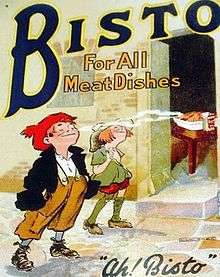Bisto
Bisto is a well-known brand of traditional British foods in the United Kingdom, most famous for its gravy products.
History

The very first Bisto product, in 1908, was a meat-flavoured gravy powder, which rapidly became a bestseller in the UK. It was added to gravies to give a richer taste and aroma. Invented by Messrs Roberts & Patterson, it was named "Bisto" because it "Browns, Seasons and Thickens in One".[1]
Bisto Granules, which dissolve in hot water to form a gravy substitute, were introduced in 1979. As of 2005, Bisto Gravy Granules have a British market share in excess of 70%.[2] Most UK grocery outlets stock a Bisto product.[2]
Flavours
The famous red packets are the "favourite" flavour, purportedly beef flavour (although it contains no beef). Bisto also comes in varieties to accompany chicken, turkey, lamb, and other meats.
In 1991, Bisto launched a new, more expensive, beef-like granule. Packaged in a glass jar, it offered a fuller flavour than the standard granule. Fuller flavour chicken and onion variants were added in 1993, and the whole range was relaunched as Bisto Best.
More recently, a ready-made Bisto "Heat And Pour" gravy has been available in beef and chicken flavours. This comes in plastic pouches suitable for heating.
In 2004, Bisto diversified into chilled and frozen products by introducing Bisto Roast Potatoes, Bisto Crispies, Bisto Yorkshire Puddings and Bisto Frozen Mashed Topped Pies.
Bisto also makes a range of sauces, including white sauce, cheese sauce, curry, and parsley sauce in granulated form, as well as a range of casserole sauces, all in glass jars.
Advertising
Bisto is notable both for the age of its brand and for the advertising campaigns it has used. In 1919, the Bisto Kids (created by illustrator Will Owen (1869–1957) [3]) appeared in newspapers and soon became popular. The Bisto Kids were a boy and girl in ragged clothes, who would be illustrated catching the odour of Bisto on the breeze and exhale longingly, "Aah, Bisto!"
In Birmingham in the 1930s a competition was held to choose a name for the two Bisto twin characters, a boy and a girl smelling Bisto's gravy. The competition was won by Mr and Mrs Simmonds, who named the twins after themselves, calling them Bill and Maree. They were awarded a china doll.
The Bisto Kids were also part of more elaborate advertising campaigns in later years. Although the Bisto Kids have not been included in Bisto advertising since 1996,[4] many people still recognise them.
During the 1980s, the company released a series of ads in the UK which featured a song that included the recurring phrase, "Never in a month of Sundays". In 1984 RHM Foods launched a nationwide competition to find children to act the role of the Bisto Kids, the recurrent "The Bisto Kids of the Year Awards". The first ever competition was won by Hayley Griffiths and Jimmy Endicott from Doncaster. They were six years old at the time and became the faces of Bisto, both for public relations and marketing events, and also appeared in an advert shown on prime time TV to find the next Bisto Kids.
The company sponsors the Bisto Book of the Year Awards in the Republic of Ireland.
The latest campaign for Bisto encourages families to sit up at the table for one night a week to eat 'proper' food.
Ownership
Bisto has had several owners since its creation. It is currently owned by Premier Foods, which acquired Bisto when it bought Rank Hovis McDougall in March 2007 to form the largest UK foods manufacturing company.
Competition
Bisto's main competitor is Goldenfry Foods Ltd, which makes a branded gravy as well as most supermarket own-brand gravies.[5]
References
- ↑ http://www.bisto.co.uk/about
- 1 2 ACNielsen Total Grocers MAT 2005.
- ↑ "198: Will Owen (1869-1957) "Ah! Bisto" Bisto for all me". Retrieved 11 December 2015.
- ↑ Rebecca Fowler (23 October 2011). "Ah! Gravy train over for Bisto kids". The Independent. Retrieved 11 December 2015.
- ↑ Goldenfry - Case Study - Ripe Design London, Leeds, Cape Town A creative web, print and new media design agency
External links
- Bisto website
- Bisto brand page at Premier Foods website
- Bisto for Caterers on the RHM Foodservice website
- BBC article